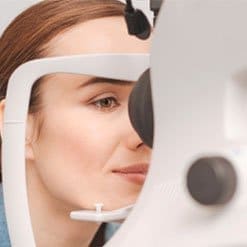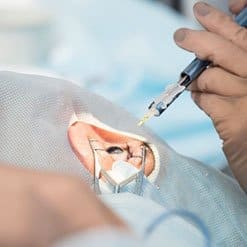Prostheses and epiprostheses of eye
Table of Content
 Dear Patient,
Dear Patient,Loss of the eye may be for you a heavy burden , and it raises a lot of questions. This information will help you get answers to most important questions related to this topic.Thorsten Meyer
Ocular-prosthetic from Munich , with over 15 years of experience;
Makes eye protheses and epi- prostheses for the Centre for Eye Microsurgery OPTOMED
Prosthetics
Various injuries and eye diseases as well as birth defects may result in the need to wear an artificial eye. The eye prosthesis protects and prevents shrinkage of the orbit. In order to fit an eye prosthesis, it is not necessary to remove the eyeball. In such a case, the so-called epe- prosthesis is made . In our clinic, prosthesis and epi- prosthesis are made from glass.. They are individually tailored to the patient’s eye sockets. Faithful imitation of the eye makes that the prosthesis does not attract attention, and the patient feels more confident.
Types of eye prostheses
It has become a necessity to tailor individually prostheses and epi-prostheses . There are two basic types: acrylic and glass. Prostheses made from glass have many advantages. Their surface is smooth, resistant to scratches and accumulation of excess protein, which in the process of denaturation can become a strong allergen, leading to severe complications. In patients with orbit implantation, there may be allergic complications, which may finally cause the rejection of the implant. Prostheses made of acryl are mechanically resistant but accumulating protein in the micro pores lead to more frequent replacement. They also get moisturized much worse , which causes accumulation of dried protein on their surface. Prostheses should be produced by casting method , and after completion of treatment, they should be repainted and polished.
Why glass?
Because glass is not only neutral, but also devoid of harmful substances; it is the best tolerated material for the production of ocular prostheses and epi-prostheses Eye prostheses surface made of glass are tight and smooth. For this reason, the prosthesis, like a healthy eye is optimally wetted by tear fluid. Eye prostheses made from glass has a natural shine and eyelids close smoothly.
Making (individually customized)
Eye prosthesis is fitted individually in the presence of the patient. First, a suitable shape is chosen, then colour. Production takes about 1-2 hours, during which you will learn all the details of care and procedure instructions with a glass prosthetic eye, and you will be trained how to put it in and take it out.
For whom?
Prostheses at our clinic are made for both children and adults ,with diseases of the eyeball or lack of it . For children, early fitting and regular replacement of prostheses ensure an adequate development of orbital structures together with the development of the child.
Consultation
The consultation should be arranged by contacting Eye Microsurgery Center OPTOMED. In the case of earlier implantation of orbital prosthesis, it can be made earliest from 5-6 weeks after surgery. If on the eyelids or around the eye socket are seams or inflammatory changes, please notify us when arranging the date of visit. Prosthesis will be made immediately on the visit day.
Refund
We would like to inform you that our Clinic has an agreement with the National Health Fund for reimbursement of eye prosthesis. The refund covers most of the costs associated with the purchase of the prosthesis, and the patient pays the difference between the cost of the prosthesis or epi-prosthesis and the refunded amount.
The refund applies to patients insured in the National Health Fund: for adults once every 5 years, and each time for children up to 18 years of age.
To obtain a refund from the NFZ, the patient must first go to an eye specialist, who has a signed contract with the National Health Fund, who will issue an order for the supply of prosthesis and other medical items. Then, the properly issued order should be stamped in the Department or the Branch of NHF, relevant for the place of residence. The order is valid for 30 days from the date of issue by the doctor, but NHF may set another date for realisation.
Time of wearing
Eye prosthesis must be regularly replaced. The wearing of the prosthesis, due to the resistance of the material is longer than in case of acrylic prosthesis . Dust and dirt, for example, in the workplace as well as environmental impacts may, however, reduce this time. More frequent fitting of a new prosthesis is necessary in children and adolescents, as they are in the growth phase. Regular consultations with an ophthalmologist and exchanges of eye prosthesis ensure comfortable wearing.
Additional information
Below, click to download a file on care and handling procedures concerning eyeball prosthesis / epi-prosthesis. Click to download.
Album


Both eyes are examined
Consultation with Mr. Thorsten Meyer
Included cost of one day stay
Included cost of one day stay
123,00






